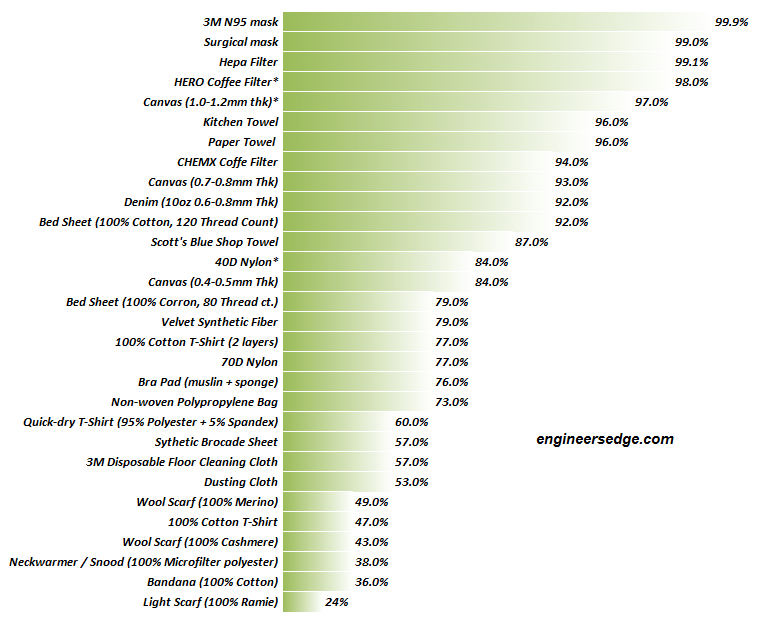Related Resources: filtration
DIY Face Masks Design Materials
Filtration, Filters Engineering and Design
DIY Face Masks Design Materials for COVID-19 Virus
Ideally, a N95 respirator performance would be your goal, however the availability of these face mask respirators can be limited in today' COVID-19 pandemic. The N95 is the most common of the seven types of particulate filtering face piece respirators. A N95 face mask filters at least 95% of airborne particles but is not resistant to oil.
A surgical N95 respirator is a NIOSH-approved N95 respirator that has also been cleared by the Food and Drug Administration (FDA) as a surgical mask. These products are noted in bold font on the table of NIOSH-approved N95 respirators.
The National Institute for Occupational Safety and Health (NIOSH) is the U.S. Government agency responsible for the certification and approval of respiratory protective devices for occupational use. The authority is granted to NIOSH in accordance with conditions and standards established in Title 42 of the Code of Federal Regulations (CFR), Part 84. It also addresses quality assurance requirements for the manufacturing of respiratory protective equipment. The approach to approval is that anybody can manufacture and sell any type of respiratory protective device, but only those that meet or exceed all of the requirements established in the 42 CFR Part 84 standards are acknowledged by NIOSH, and only those that have been NIOSH certified may be marketed as a NIOSH-approved respirator.
The following are Personal Mask Materials that performance was measured against filtering out 1.0 micron particles (Approximate size of Ebola Virus)

Reference: Smart Air Filters testing using a Modified Henderson Apparatus
Note:
1 is the most breath-able or least resistant to free flow of air
10 = Most resistant to free breathable air flow
|
Materials Tested
|
Breath-ability |
| 3M Disposable Floor Cleaning Cloth |
6
|
| Velvet Synthetic Fiber |
6
|
| Quick-dry T-shirt (95% Polyester + 5% Spandex) |
6
|
| Synthetic Brocade Sheet |
6
|
| Wool Scarf (100% Merino) |
6
|
| HEPA Filter |
6
|
| 100% Cotton T-shirt |
6
|
| Non-woven Polypropylene Bag |
6
|
| Bandana (100% Cotton) |
6
|
| Wool Scarf (100% Cashmere) |
6
|
| Neck warmer / Snood (100% Micro fiber Polyester) |
6
|
| Light Scarf (100% Ramie) |
6
|
| Dusting Cloth |
6
|
| Canvas (0.4-0.5mm thick) |
6
|
| Surgical Mask |
5
|
| 100% Cotton T-shirt (2 layers) |
5
|
| Bra Pad (muslin + sponge) |
4
|
| 70D Nylon |
4
|
| Paper Towel For Hand Drying |
3
|
| Bed sheet (100% Cotton, 120 thread) |
3
|
| Bed sheet (100% Cotton, 80 thread) |
3
|
| Denim (10oz, 0.6-0.8mm thick) |
3
|
| 3M N95 mask |
3
|
| Kitchen Towel |
3
|
| CHEMEX Coffee Filter |
2
|
| Canvas (0.7-0.8mm thick) |
2
|
| 40D Nylon* |
1
|
| HERO Coffee Filter* |
1
|
| Canvas (1.0-1.2mm thick)* |
1
|
Reference: Smart Air Filters testing using a Modified Henderson Apparatus (Data does not appear to be peer or standards reviewed)
Overview of filter types, definitions and related specifications
Air Density: Air density equals 0.075 lb/ft3 (1.201 kg/m3 ) for standard air. This corresponds to air at a pressure of 29.92 inches Hg (760 mm Hg) at a temperature of 69.8°F (21°C) with a specific volume of 13.33 ft3 /lb (0.832 m3 /kg).
Airflow (ACFM): Airflow expressed in terms of actual cubic feet of air per minute (ACFM). ACFM is a measurement of volumetric flow of air with a density at actual existing conditions.
Filter Types:
Open-Face Filters: A filter with no restrictions over the ends or faces of the unit, as opposed to the enclosed filter with reduced-size end connections.
Axial Flow Filters: A filter with airflow in a direction essentially perpendicular to the filter face.
Radial Flow Filters: A filter with airflow in essentially a perpendicular direction outward from the centerline of the inside face of the filter or, conversely, inward.
Enclosed (Encapsulated) Filters: A filter that is completely enclosed on all sides and one, or both, face(s), except for reduced end connections or nipples for direct connection into a duct system.
Penetration: The downstream test aerosol concentration, expressed as a percentage of the upstream test aerosol concentration.
Qualification Test: A group of tests, some destructive, of a prototype filter or production filters that demonstrates that the design meets the appropriate requirements of a filter or filter system.
Rated Airflow: The designated airflow capacity of a filter.
References:
Centers for Disease Control and Prevention (CDC)
Smart Air Filters
The National Institute for Occupational Safety and Health (NIOSH)